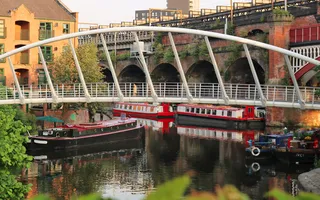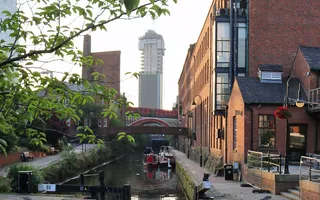By the late 1800s, Manchester was spinning cotton for the world, and hordes of cotton mills earned the city its nickname ‘Cottonopolis'. Manchester was home to the first canal, leading the way for the fortunes of the nation, and the Rochdale Canal, completed in 1804, was the first trans-Pennine water route, busy with barges laden with cotton, coal, grain and wool. Today this buzzing contemporary city embraces its water, making an intriguing and dynamic walk.
Canal walk from Castlefield
This one and a half mile walk leads through the heart of Manchester’s canal heritage, passing restored former mills and warehouses and even diving under buildings.

Canal: Rochdale Canal
Start: Castlefield Junction OS Grid ref: SJ830975 Postcode: M3 4LZ
Finish: Ducie Street Junction OS Grid ref: SJ848981 Postcode: M1 2JB
Distance: 2.4km / 1½ miles
Route instructions
Start: The dramatic Castlefield Junction is where the Bridgewater Canal ends and the Rochdale Canal begins. Castlefield Basin provides boat moorings and is a stunning blend of heritage buildings and contemporary additions. Coal Wharf, now a car park, hints at its original purpose to unload coal from the Duke of Bridgewater's mines in Worsley. The Grocers' Warehouse was reputedly the first warehouse in Britain to unload barges inside the building using a water-operated crane – a system developed by the famous canal engineer James Brindley in 1765 to unload coal from the canal up to street level.
1. Grade II-listed Castlefield Viaduct dominates Castlefield Basin and part of the canal. A section of it has recently been transformed into a ‘sky park' filled with over 3,000 plants and trees, which will offer visitors the opportunity to stroll high in nature above the city.
2. Setting off from the cobbled Castle Street Bridge by the stunning Merchant's Warehouse, follow the towpath of the heavily locked Rochdale Canal as it starts its climb out of Manchester at Duke's Lock. Boaters have to concentrate here as visitors to the pub alongside keep a watchful eye over their manoeuvres. The lock is last in a series of nine double locks, known as the Rochdale Nine and all now Grade II-listed, which drop the canal from Piccadilly to Castlefield.

3. The towpath passes under the ornate skewed red and white cast-iron Deansgate Railway Viaduct, next to a small canal arm, before disappearing briefly under Deansgate Tunnel Bridge which carries the A56 over the canal.
4. Between locks 91 and 90, a series of bridges cross the canal to the trendy area of Deansgate Locks, with popular bars housed in the railway arches. The towpath heads under Albion Bridge and along a stretch enclosed by buildings, opening up again around Tib Lock 89 and Tib Basin.
5. The canal is lined with restored warehouses and new apartment buildings before you need to duck your head under Oxford Street Bridge to lock 88. The view ahead shows the tall chimney of the now Grade II-listed Bloom Street Power Station. Coal used to be unloaded straight into its bunkers from canal barges on the water.

6. Go under Princess Street Bridge and turn at the lock to cross the footbridge to the opposite bank. Follow Canal Street as the canal travels through the now world-famous gay village, passing Chorlton Street Lock. Be aware of cars as you cross over Sackville Street and Chorlton Street.
7. At Minshull Street Bridge, cross to go through the gate to re-join the towpath. After Aytoun Street Bridge, the canal disappears into Piccadilly Tunnel, a dramatic world of columns and colourful artwork under a towering 18-storey office block for Piccadilly Lock. It can be low in parts so keep your head down.
8. Coming back up for air at Dale Street Lock, turn up the slope to the road and cross to the other side of the canal. Go through the original entrance arch to Piccadilly Basin by the now Grade II-listed Rochdale Canal Company Offices to rejoin the towpath. There is much regeneration around this area including the restoration and repurposing of canalside mills and warehouses, such as the Grade II*-listed Carver's Warehouse near Dale Street Lock. Built in 1806, it is the earliest surviving canal warehouse in Manchester.

End: Benches offer the perfect vantage point to watch boats negotiate the right turn under the buildings of Ducie Street to the Ashton Canal, while the Rochdale Canal continues its climb north. And when you're ready, hop on a bus or retrace your steps back to Castlefield from a new angle.

Last Edited: 8 May 2024


Stay connected
Sign up to our newsletter and discover how we protect canals and help nature thrive


